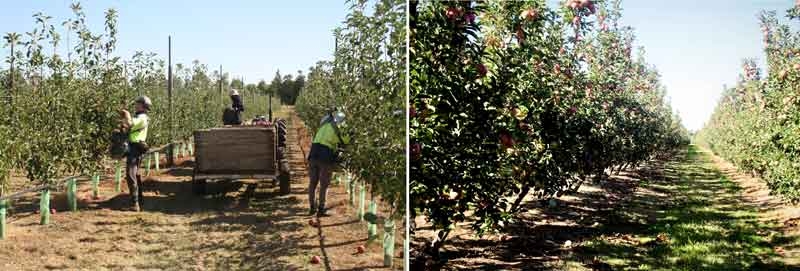M.9 sensitive to high soil temperatures
M.9 sensitive to high soil temperatures (continued from last month)
It is well known that M.9 is sensitive to high soil temperatures, i.e. above 25C, possibly because M.9 does not grow new roots, especially feeding roots.
In countries with long hot summers, tree vigour can be low in many apple orchards on M.9.
Roots grow best in the range of 20C to 25C. Above 25C root growth slows, and above 35C no new roots grow.
This means that with long hot summers, root growth of trees on M.9 is restricted, especially in the upper depths of soil where most of the feeder roots grow.
Soil temperatures of 37C and 33C have been recorded in an Ardmona (Victoria) apple orchard at 60 mm and 120 mm depths respectively, when the ambient temperature was 40C, and five hours after the microjet irrigation was turned off.
At a more common ambient temperature of 33C, the soil temperatures at 60 mm and 120 mm depths were 32C and 29C respectively.
The distribution of assimilates between roots, frame and fruit is ultimately controlled by the growth of the roots.
Roots not only store carbohydrates and nutrients, roots also synthesise growth substances such as cytokinins and gibberellins. These growth substances produced in the roots are transported to the top of the tree and control shoot growth.
When growth of the root system slows down or stops altogether at high soil temperatures, the production of cytokinins in new roots may also slow down or stop, limiting shoot growth.
Thus, decreased root growth decreases shoot growth. There is no doubt that roots, acting through a hormonal control, play a major role in the maintenance and balance of the growth of the whole tree.
High root zone temperatures also reduce tree growth of stone fruit in inland parts of Australia, where summer soil temperatures, particularly during the day, can be hot.
Modi trees on M.9
In an Ardmona orchard in north-central Victoria, shoots of young Modi trees on M.9 actively grew in October and November and had virtually stopped in December.
Average day temperature in December was 27C—with nine days above 30C, and the highest day temperature of 36C.
Trees stunted, not dwarf
Based on tree size (trunk cross-sectional area), it has been estimated that full canopy of the Modi trees on M.9, planted 4 x 1 m, will take seven or eight years. The benchmark for full canopy (and full crop) for trees on M.9 is five years.
Apple trees on M.9 in some orchards in mainland Australia appear stunted rather than dwarfed, canopy development has been relatively slow and fruit on these trees have been severely sunburnt.
Need a range of vigours
M.9 on certain soil types will not sustain the vigour needed for each combination of tree density.
In Australia, a range of vigours will be needed for the different apple growing regions with different climates and soils, as M.9 vigour may be too weak for some soils.
A good understanding of the interactions between rootstocks and varieties, and climate and soil, would help growers select better rootstocks in the future.
Lessons from overseas
In some countries (e.g. Chile), there has been a significant trend towards high-density planting on M.9 rootstocks in newer blocks, but semi-dwarfing rootstocks such as MM.106 and M.7 are planted on new adjacent blocks.
(continued next month)
See this article and images in Tree Fruit June 2017






















